Starfield Review
Bethesda have achieved great things with just a few worlds. Across two franchises, they have exploited the regions of Tamriel in Elder Scrolls and the post-apocalyptic wastelands in Fallout. Both series have become incredibly popular, so who could blame them for staying the course. Starfield is their first original setting in decades, and although set in a big new universe, its working parts are familiar. Its defining feature is a great sense of scale, with customizable spaceships to fly across dozens of systems and hundreds of procedurally-generated mini-worlds to explore. It encourages freedom, whether that means saving worlds from alien beasts, building outposts, dogfighting in space, or journeying with a companion across barren moons. Starfield is big and glorious, and only rarely overwhelming.
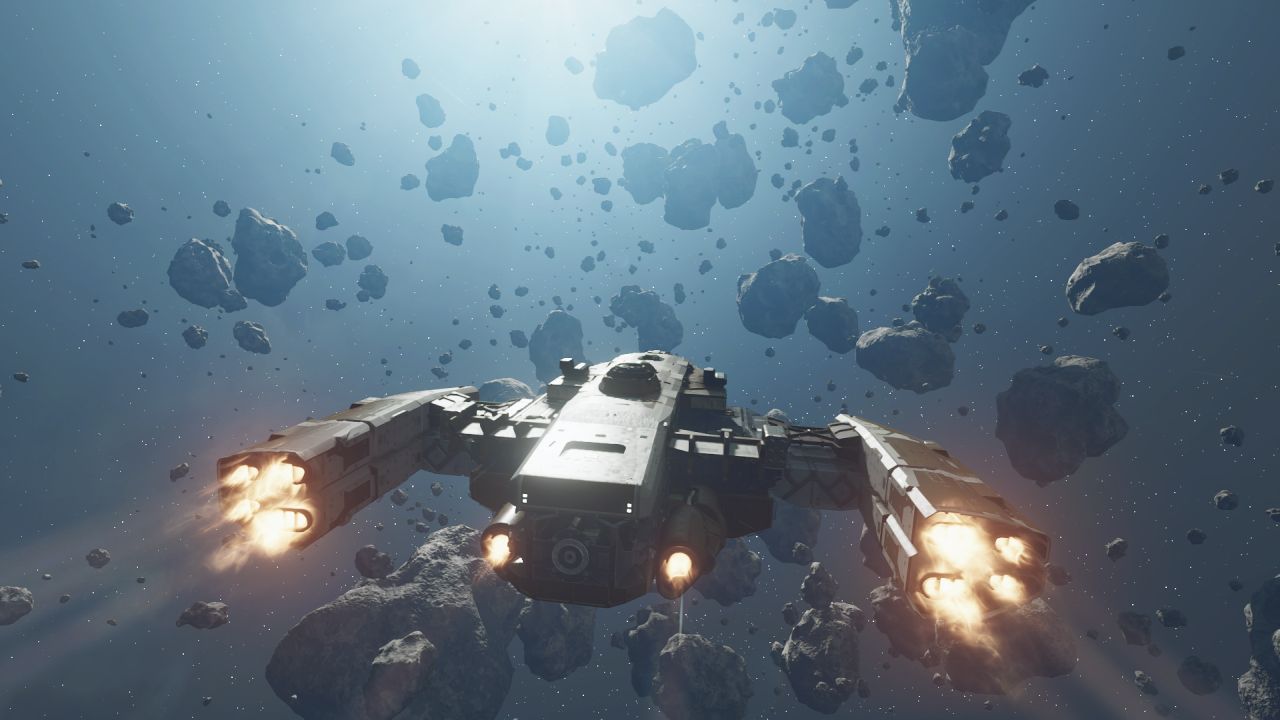
The interstellar adventure begins from a hole in the ground. You start as a newbie miner on a remote moon and extract a strange metallic artifact that gifts you a vague cosmic vision. The encounter knocks you unconscious and, thanks to medicine in 2330, you get to create a human form with a robust character-creation tool. Here you pick face presets, adjust body sizes, change noses, and make refinements. While the custom faces are pretty good, the hair styles are shabby and limited. You also select a character background and perks that occasionally pop up in quest dialogue. When you are finally shipshape, it is time to ship out. A member of an elusive exploration group, known as Constellation, asks you to take their spaceship and bring the artifact back to their headquarters in New Atlantis, the largest city in the Settled Systems.
Constellation are a diverse group of explorers, desperate to learn about the unknown. Sarah Morgan is their leader, and ex-soldier who has been through the wars in more ways than one. Walter Stroud provides funding, as CEO of a spaceship manufacturing company. And Sam Coe is related to a famous explorer and is raising his daughter alone. Other Constellation members bring their own strengths, and you get to know them in time. There is good writing and voice work for the main group, no better demonstrated than when they express unique beliefs after a tragic incident. All want to understand the artifacts, and while the group has a few already, something weird happens when yours is added to the pile. They come alive, almost, floating up into a rotating sphere. Constellation request that you bring back more, with a few clues to get you started. Although the main storyline is decent and has cool similarities to Skyrim, it is stretched thin and certain Constellation members needed more involvement.
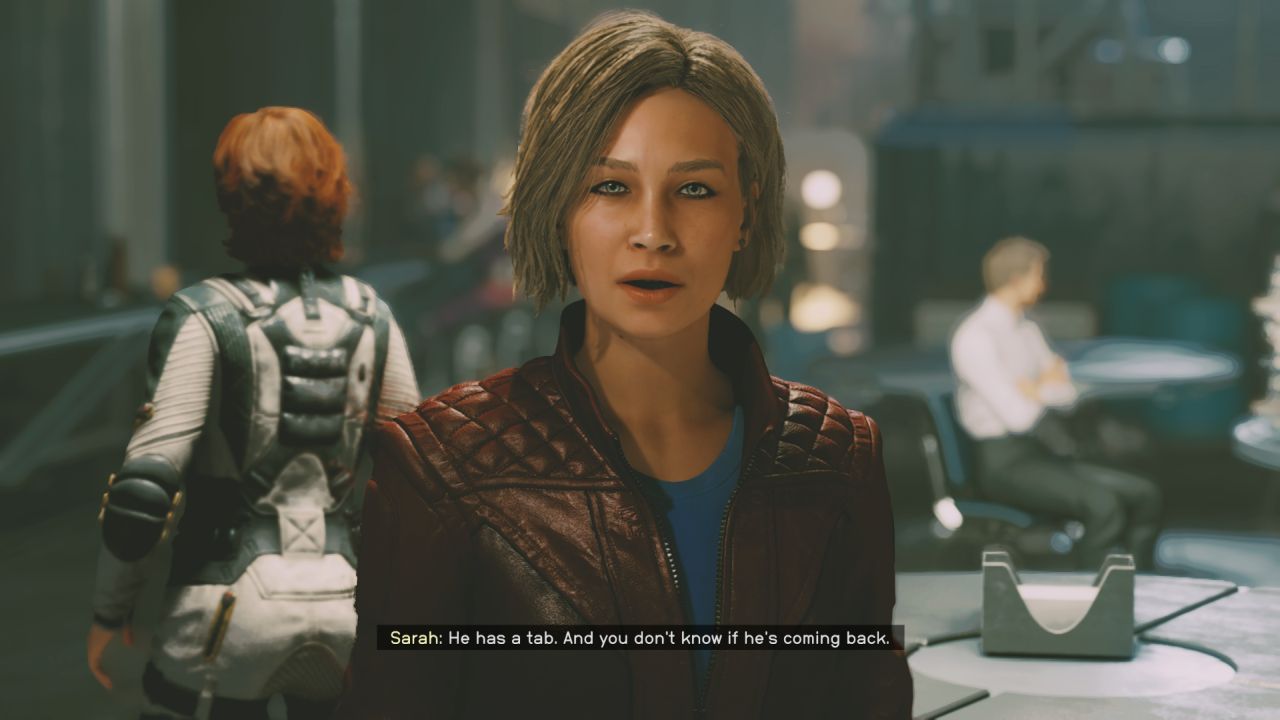
Some of Constellation’s team can join you as companions. Unless you plan on sneaking about or breaking the law, bringing a companion is worth it because they help in combat and carry equipment. Companions occasionally speak during conversations, although most other participants tend to ignore them. They offer great debriefs at the end of major quests and occasionally want to talk in private, bringing up their all-too-tragic pasts with unresolved issues that only you can help with. The frequency of private chats increases if you do things they appreciate, which usually means being morally good. Eventually, it all leads to a lengthy companion quest, although these annoyingly bind that character to your hip until it is completed. At the end, they might become friends or romantic partners. While not on Bioware’s level yet, companions are an iterative improvement over Bethesda’s previous efforts. It is a shame that only one can tag along at a given time because exploring the quiet moons would have benefitted from some banter.
With or without help, where you explore is completely up to you. Constellation has given you the keys to their modest spaceship, called the Frontier, to navigate the many star systems occupied by humans (the only intelligent beings) and strange alien wildlife. The ship’s faster-than-light drive facilitates jumps between planetary orbits, within a certain range. Once you land on any planet or moon, fast travel is unlocked and so zipping back and forth, without getting inside the ship, will become common. The Frontier has basic weapons too, needed to fend off space pirates roaming in orbit above planetary bodies.
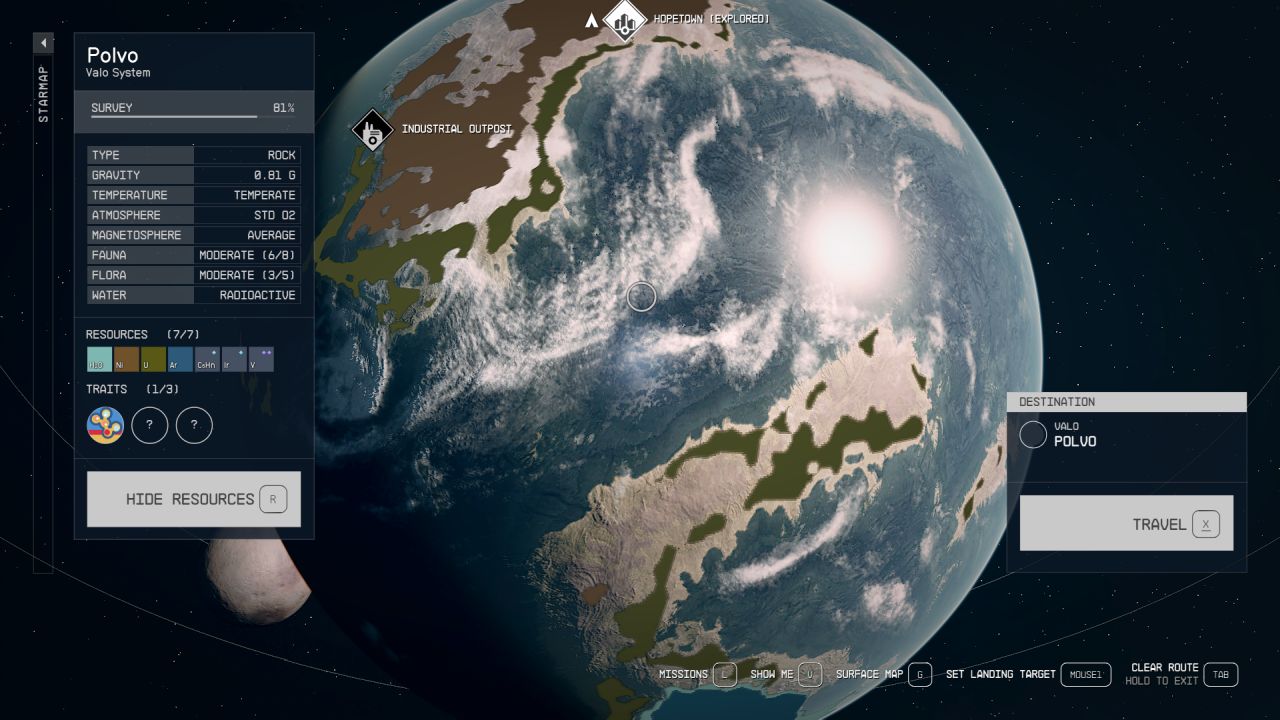
Starfield is not a full-size or continuous representation of space. It provides the clever illusion of scale. In orbit around worlds, you drift through a patch of space, maybe between asteroids that can be destroyed for resources. There are many funny encounters in orbit, like fielding questions from passengers on a space tour, being hailed about your ship’s extended warranty, and receiving an offer to party in zero-gravity. From orbit, the ship cannot seamlessly land on a planet like in No Man’s Sky; you must pick a landing spot from the excellent 3D planet overview and the game teleports you just above the surface for an automatic touchdown.
Aside from major destinations, the area around each landing spot is procedurally generated, offering a good compromise between scale and practicality. The modest stretch of land allows players to run for about ten minutes before the game tells them to stop, go back, there is nothing more to see. Areas are dotted with natural wonders and structures, like scientific outposts, caves, spaceship debris, and drilling platforms, which can be spotted with the scanner and marked on the weirdly featureless surface map. Alien flora, fauna, and minerals can be scanned and harvested to craft gear upgrades. You can optionally plunk down an outpost on any vacant patch of land, assuming the environmental conditions are suitable, but more on that later. The initial forays through random worlds are captivating, with eerie walks across rocky moons and busy sprints through jungles teeming with hostile creatures. Some uplifting orchestral music from Inon Zur also regularly helps to set the perfect tone.
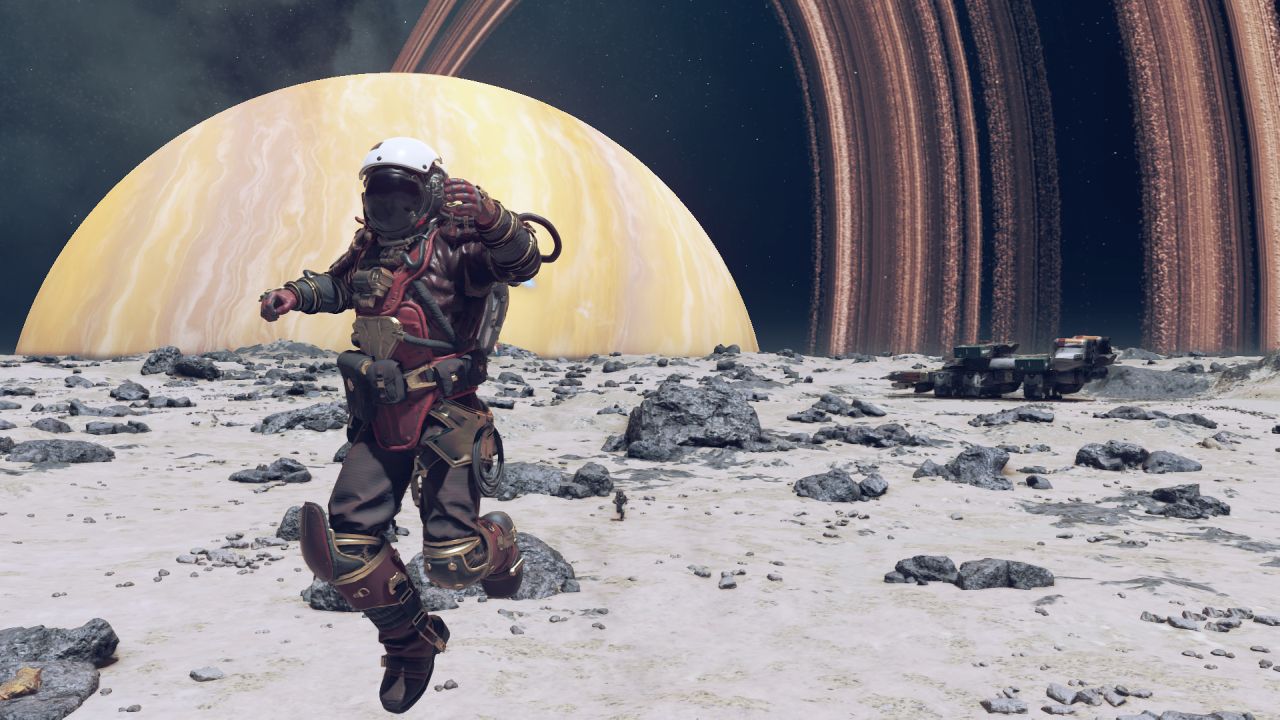
After exploring dozens of randomized worlds, the sense of wonder gradually faded. Points of interest are identical across different worlds so exploration became repetitive, even though biomes differ significantly, random quests occasionally appear, and space vistas remained glorious—with fully simulated orbits and rotations. Also, since the ship cannot be repositioned, and despite how fun it is to bounce across low-gravity environments, the game needed an alternative transport method to merely running far and wide; some kind of moon buggy would have been ideal.
Across the many planets in the Settled Systems, there are several awesome, hand-crafted destinations, each worth more than a hundred procedural worlds. Go to Neon, a cyberpunk city suspended above an ocean world, and visit a nightclub where a contraband drug is abused. Head to Akila, a town influenced by the Old West, and trudge through the muddy streets while gangs stir up trouble. Get your ass to Mars and enter the underground outpost to assist miners barely surviving. The scope of these places is impressive and many leave a striking impression similar to Skyrim, with hidden corners to uncover and picturesque views. They make great use of the Creation Engine, with good interior lighting, busy detail, and diverse atmospheric conditions. Some of the art design, particularly for the little details like space food and furniture, is above the typical Bethesda standard. All hand-crafted destinations feel like they belong to their own corner of the universe, with specific problems and unique factions trying to solve them.
Major factions are desperate for help and will reward you handsomely. This is the time to be a hero and that is when Bethesda’s games tend to shine, and Starfield is no exception. The Rangers of the Freestar Collective want to bring law to the lawless, and request you help a farmer being harassed by mercenaries. Vanguard soldiers on New Atlantis have an evolving situation involving a mutant hostile alien that, if not fixed, will put an end to all of humanity. A mega-corporation hires you to amusingly bring coffee to other employees and then, upon seeing your potential, asks you to undertake sneaky corporate espionage. There is outstanding variety and most faction quests are more interesting and enjoyable than those on the main path, due to choice-based outcomes and great characters.
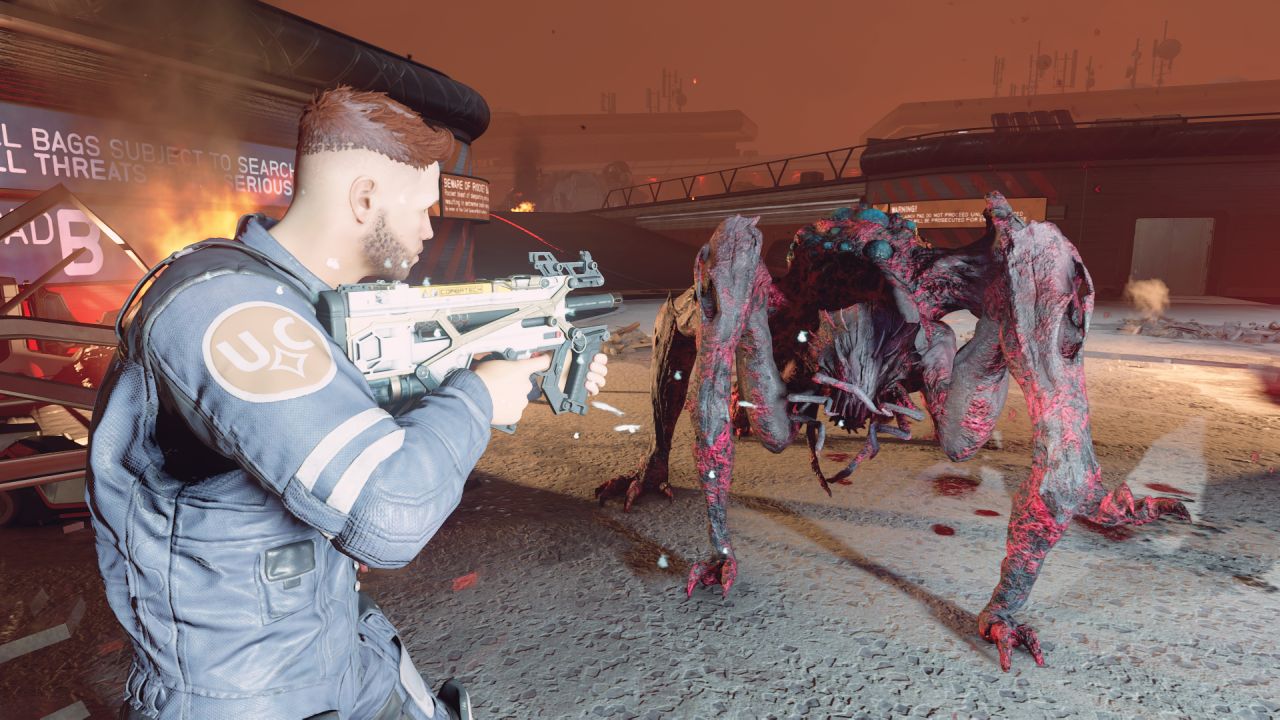
The number of quests is overwhelming and not always well distributed. Many have early stages that lead to distant worlds, which exposes more quests and more factions, and makes it hard to stay on track. Since each step does not take long, players are encouraged to complete multiple objectives or they will spend even more time travelling back-and-forth. It is a balancing act between ignoring the many pleas for help and getting swept away by a quest avalanche. And because the latter was more natural and efficient, the game shows its best features in a big clump. It would have been nice to spend more time in a local area and have a slower journey across the stars. But even in the back half of the 80-hour game, when there is not much new to see, there is still plenty left to do.
Quest structure is simple and similar to Bethesda’s previous games. You follow the quest icon and kill targets, ferry items, activate equipment, and interact with people. There is lots of talking and fortunately your character can pick from some downright hilarious responses. Sadly, most characters rebuke jokes, which means the stoic heroic response is usually best. Quests can sometimes be solved a few ways. Bribery is on the cards, with enough credits and the right skills. Persuasion helps to avoid sticky situations, and this is easier when wearing a fancy suit. Stealth is clumsy out of the box, improved with gear and upgrades, but pick-pocketing mission-critical items is always fun and a silenced sniper can clear camps covertly.
Shoot first and loot later is the default approach when hostiles are involved. The frequent combat encounters improve after unlocking more skills. You can specialize in certain weapon types, increase health, add a combat slide, and craft weapon or spacesuit mods. Using either first-person or third-person mode, combat is decent because there are many weapons and most handle well. You also have a jetpack, which helps to get the drop on enemies. Medical aids are conventional, with drinks that slow time and drugs that boost damage. Sadly, both allies and opponents are not the brightest bunch. Companions usually fell too far behind, arriving late to the fight, and not being able to set their behavior is annoying when they seem intent on causing the extinction of any alien species that looks at them the wrong way. Hostiles sometimes lost awareness, but at least they retreat and hide often to create surprises.
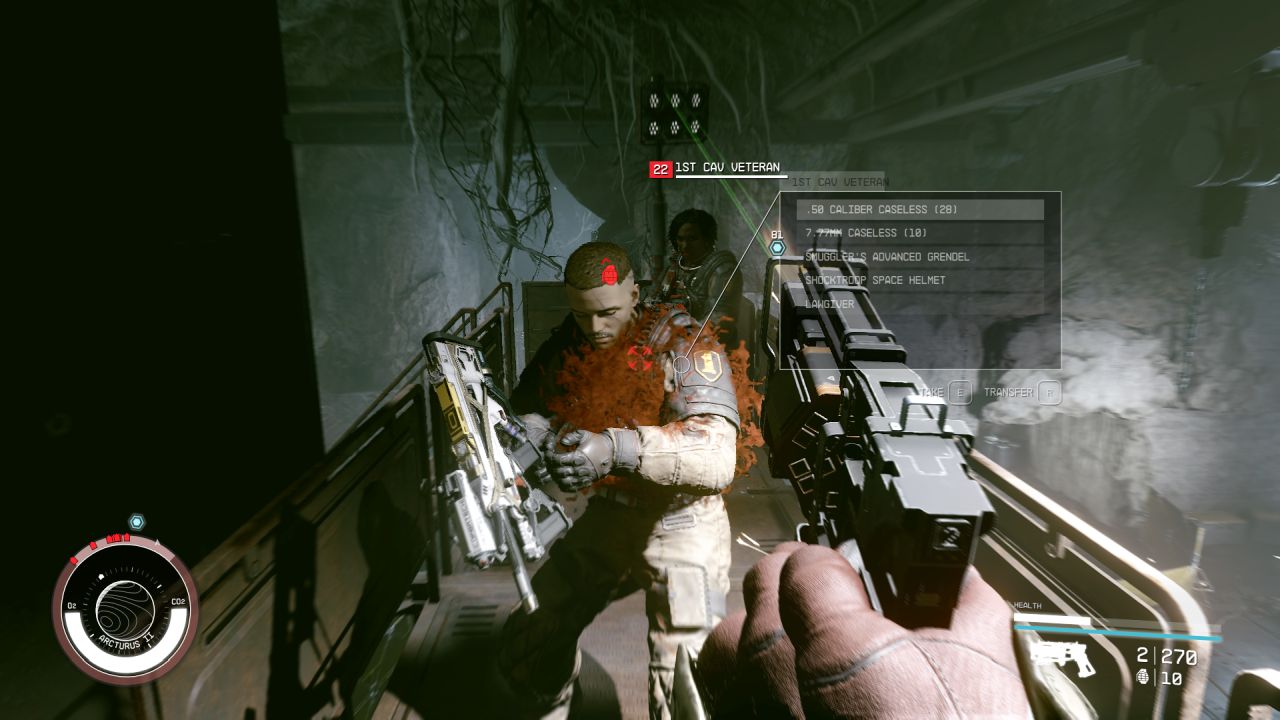
Spaceship battles offer a different kind of action experience, and are generally infrequent and short-lived. Across the first dozen hours, there were only about five space battles total. More vacuum violence can be found by taking specific bounties or spending idle time in orbit. It is possible to fly the ship using either the first-person view from inside the cockpit or a trailing third-person camera. Combat is usually about steering to aim at targets, using boost to bridge distances or avoid missiles, and allocating power to weapons, shields, or engines. It is enjoyable to destroy pirate ships and swoop in to collect the salvage. Occasionally, the ship combat gets silly when turning and turning, for an eternity, before a target comes into view, only for an allied ship to land the killing blow. With one early ship skill, you can target individual systems (think V.A.T.S. in space) and this is fantastic because it is possible to disable engines, forcibly dock, kill all occupants, and steal the ship to either sell or add to your collection.
Modifying ships is a satisfying way to build any vessel that suits your needs, whether that is a nimble fighter, cargo hauler, remote crafting center, or jack of all trades. Some quests even require ship modifications. At first the modification system is clumsy, due to many hidden rules. Cargo space, while wonderful for storing all that extra junk, requires more landing gear. Engines help maneuverability but might overload the reactor. Once you get the basics down, building a ship is satisfying and easy. You pick modules and snap them together lickety-split from an isometric viewpoint. Change the ship’s color, place some fancy cowling for visual flair, and add portholes that offer scenic views of pirate ships blasting you out of orbit. It is overwhelmingly cool to not only walk through the modified ship interior but also see it in the distance when exploring a planet or space station.
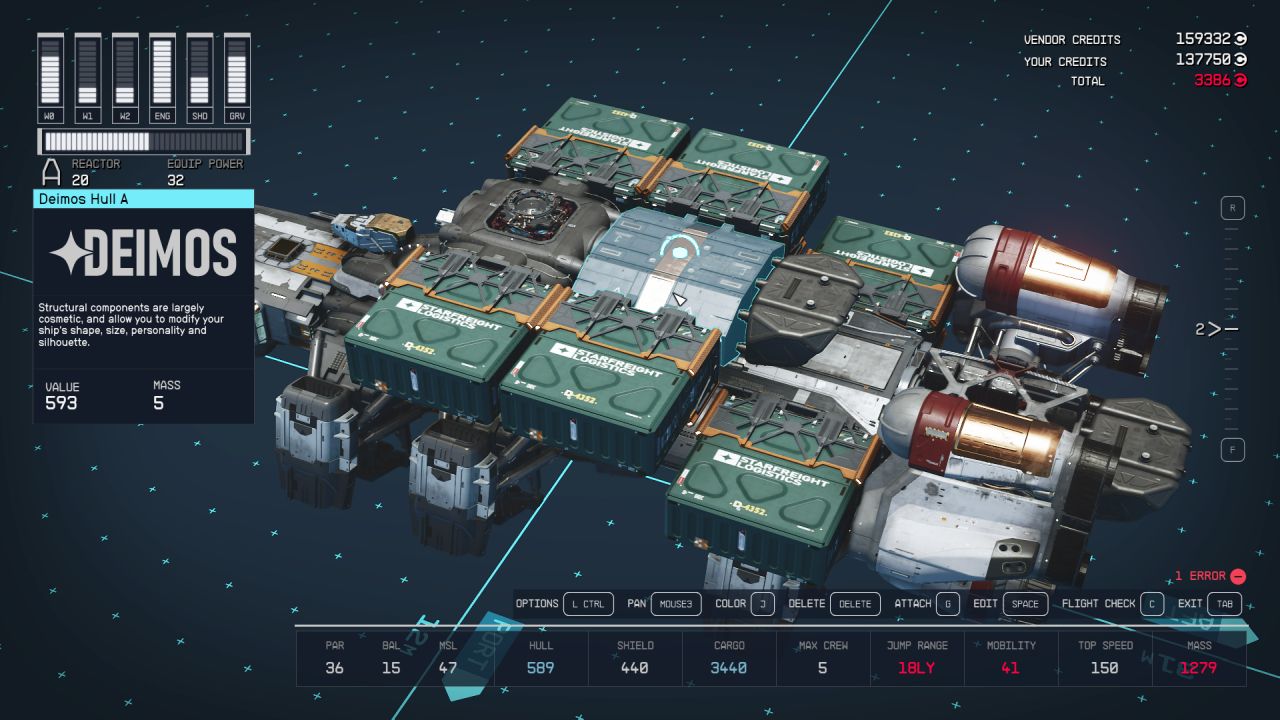
While ship building has real and practical applications, outpost construction is less important. Unlike the fun we had with Preston Garvey’s outpost protection program, the outposts in Starfield can be ignored. Building them is not part of the main quest, and no side mission required either their construction or repair. This is a missed opportunity in a universe where human settlers need safe havens. Outposts can be placed on any suitable world, which is great if you get attached to a particular location, and construction can be completed from a top-down view. Building is a bit limited because, instead of placing individual sections of floors, walls, etc like in Fallout 4, you plop down large habitats that can only be slightly modified. This makes sense and looks better but is less creative and lacks appeal. Outposts are still useful because they offer a home for unused companions, a place to store items and display gear, and the extraction of minerals intrinsic to the region, bringing the adventure full circle.
Given the game’s scale, it is remarkable how it is relatively bug free. Sure there are minor issues, like characters floating or sitting backwards in chairs, but the game only crashed once. Two side quests broke, and one fixed itself after completing another job. Procedural planets are not picture perfect, with floating rocks and caves that have different gravity conditions. One procedural quest told me to rescue a miner that had been attacked by an alien creature, on a moon without indigenous life. While it generally runs okay at max settings, major destinations chugged in busy zones and there was a frustrating pause when switching weapons. It is also consistently annoying how many load screens there are, especially in main hubs like Neon, but at least it is usually possible to fast travel to a previously-visited location from anywhere.
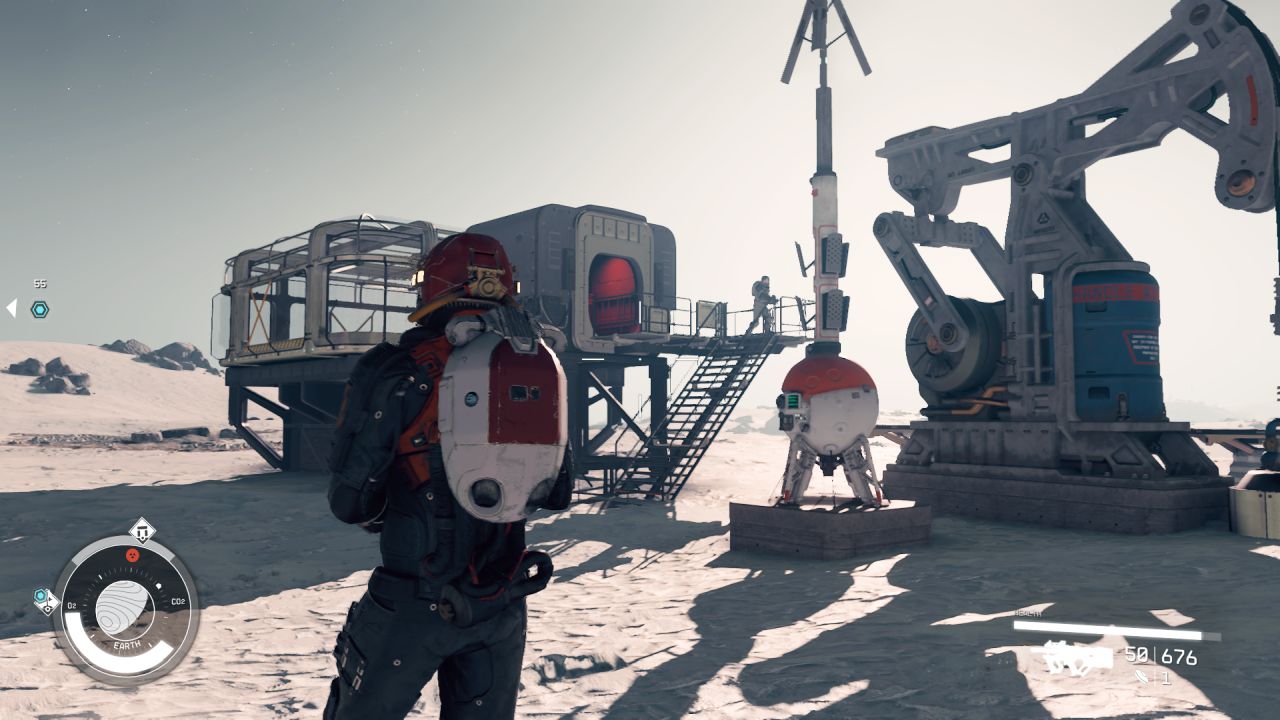
Starfield is almost the perfect merger of a Bethesda experience with space exploration. It smartly creates a sense of scale while keeping all activities within arm’s reach. With fantastic hand-crafted destinations, packed with diverse and interesting quests, it offers a lot of great content, even if it is clumped together. Procedural planets are fun to survey at first, and usually look great, although they get repetitive in time. Both space battles and ground combat are fun, and being able to customize spaceships is irrefutably awesome. And since it is relatively bug free, only the frequent load screens stand in the way of exploring the stars. With the busy gaming season now upon us, Starfield demands that players have space on their schedule.
